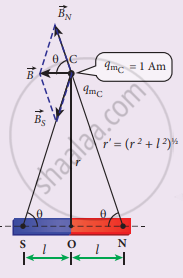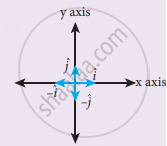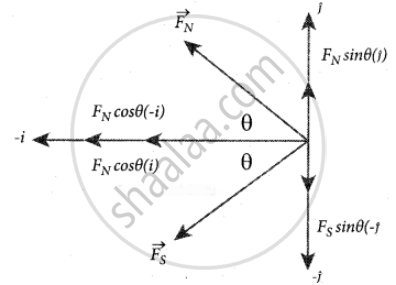Advertisements
Advertisements
प्रश्न
Obtain the magnetic induction at a point on the equatorial line of a bar magnet. Magnetic field at a point along the equatorial line due to a magnetic dipole (bar magnet).
उत्तर
Consider a bar magnet NS. Let N be the north pole and S be the south pole of the bar magnet, each with pole strength qm and separated by a distance of 2l. The magnetic field at a point C (lies along the equatorial line) at a distance r from the geometrical center O of the bar magnet can be computed by keeping unit north pole (qmC = 1 A m) at C. The force experienced by the unit north pole at C due to pole strength N-S can be computed using Coulomb’s law of magnetism as follow’s:
The force of repulsion between North Pole of the bar magnet and unit north pole at point C (in free space) is


Magnetic field at a point along the equatorial line due to a magnetic dipole
`vec"F"_"N" = - "F"_"N" cos θ hat"i" + "F"_"N" sin θ hat "j"` ....(1)
Where FN = `mu_0/(4pi) "q"_"m"/"r'"^2`
The force of attraction (in free space) between south pole of the bar magnet and unit north pole at point C is
`vec"F"_"S" = - "F"_"S" cos θ hat"i" + "F"_"S" sin theta "j"` .....(2)
where `vec"F"_"S" = mu_0/(4pi) "q"_"m"/"r'"^2`
From equation (1) and equation (2), the net force at point C is `vec"F" = "F"_"N" + "F"_"S"`
This net force is equal to the magnetic field at point C.
`vec"B" = - ("F"_"N" + "F"_"S") cos theta hat"i"`
Since, FN = FS

Components of force
`vec"B" = - (2mu_0)/(4pi) "q"_"m"/"r'"^2 cos theta hat"i" = - (2mu_0)/(4pi) "q"_"m"/(("r"^2 + l^2)) cos theta hat"i"` ....(3)
In a right angle triangle NOC as shown in the Figure.
`cos theta = "adjacent"/"hypotenuse" = 1/"r'" = 1/("r"^2 + l^2)^(1/2)` ....(4)
Substituting equation 4 in equation 3 We get
`vec"B" = - mu_0/(4pi) ("q"_"m" xx (2l))/("r"^2 + l^2)^(3/2)` ....(5)
Since, magnitude of magnetic dipole moment is `|vec"P"_"m"| = "P"_"m" = "q"_"m"`.
2l and substituting in equation (5), the magnetic field at a point C is
`vec"B"_"equatorial" = - mu_0/(4pi) "P"_"m"/("r"^2 + l^2)^(3/2) hat "i"` .....(6)
If the distance between two poles in a bar magnet are small (looks like short magnet) when compared to the distance between geometrical center O of bar magnet and the location of point C i.e., r>> l, then,
`("r"^2 + l^2)^(3/2)`
Therefore, using equation (7) in equation (6), we get ≈ r3 ……… (7)
`vec"B"_"equatorial" = - mu_0/(4pi) "p"_"m"/"r"^3 hat "i"`
Since Pm `hat"i" = |vec"P"_"m"|_"m"`, in general, the magnetic field at equatorial point is given by
`vec"B"_"equatorial" = - mu_0/(4pi) "p"_"m"/"r"^3` .....(8)
Note that magnitude of `"B"_"axial"` is twice that of magnitude of `"B"_"equatorial"` and the direction of are opposite.
APPEARS IN
संबंधित प्रश्न
A circular coil of radius 5 cm and 50 turns carries a current of 3 ampere. The magnetic dipole moment of the coil is nearly
A thin insulated wire forms a plane spiral of N = 100 tight turns carrying a current 1 = 8 m A (milli ampere). The radii of inside and outside turns are a = 50 mm and b = 100 mm respectively. The magnetic induction at the center of the spiral is
Three wires of equal lengths are bent in the form of loops. One of the loops is circle, another is a semi-circle and the third one is a square. They are placed in a uniform magnetic field and same electric current is passed through them. Which of the following loop configuration will experience greater torque?
Define magnetic dipole moment.
State Coulomb’s inverse law.
Calculate the magnetic field at a point on the axial line of a bar magnet.
